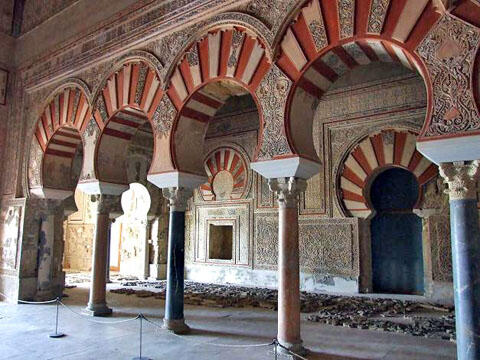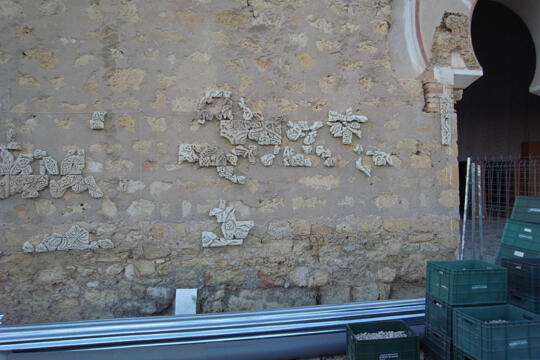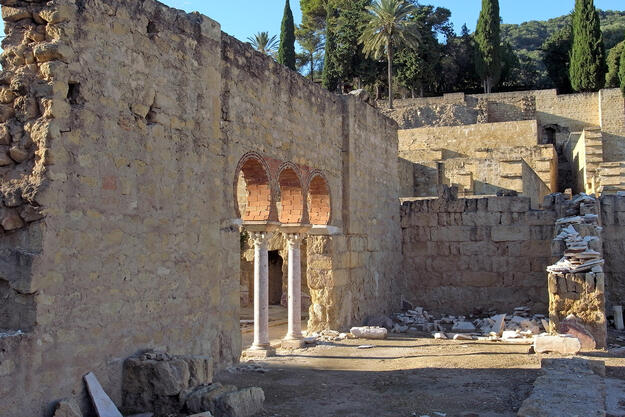The Salón Rico of the Palace of Medina Azahara
A medieval palace-city
The vast complex of Medina Azahara is a unique example of early Islamic architecture in the Iberian Peninsula. In the middle of the tenth century, Abd-el-Rahman III, who had elevated himself to Caliph of Córdoba, commissioned the building of the Medina Al-Zahra palace-city to secure his supremacy in the Al-Andalus territory. In so doing, Abd-al-Rahman was following the eastern Islamic tradition of sovereigns founding medinas, or city quarters that included both private and public areas. Built just west of the city of Córdoba, the complex included pools, houses, gardens, a throne room, a mosque, and reception rooms, among other sections. Although ruins of the medina’s walls, buildings, and narrow maze-like streets are all that stand today, the site remains a significant and rich ensemble of medieval Islamic architecture in Spain. In 2018 the site was included on the UNESCO World Heritage List as the Caliphate City of Medina Azahara in Córdoba, Spain.
Project at the Salón Rico
Our work at the Medina Azahara focuses on the Salón Rico, one of two grand reception rooms within the site that were used to welcome official delegations to the caliphate. Built into the natural slope of a hill so as to create greater height and provide a better view of the neighboring city of Córdoba, these rooms occupied a prominent place within the medina. The Salón Rico, also eponymously known as the Salón of Abd-el-Rahman III, is the eastern reception room. The room, which is laid out in three aisles separated by two rows of arches and includes an ornamental arched wall at its end, is elaborately decorated in stone and marble carvings. These carvings represent the tree of life and extend from the walls of the building to the horseshoes arches.
World Monuments Fund first became involved with restoration efforts at the Salón Rico in 2011, after research revealed that past restoration work performed there had resulted in many of the stone and marble fragments being reinstalled incorrectly. A collaboration with the government of Andalucia, early works centered on conserving the decorative elements and returning them to their proper locations when possible; sections that were missing the historic elements were rehabilitated so as to harmonize with the conserved sections. Work also included conservation of the portico, transepts, and ornamental wall in the salon, installation of a climate-control system to prevent the damaging effects of humidity, and replacement of the cement floor with one of marble that incorporated original fragments. The conservation efforts undertaken by the Junta de Andalucia in collaboration with WMF continue with support from the Wilson Challenge and the Carasso Foundation. This important work in the Salon Rico preserves this site—a complex that greatly influenced later Spanish Islamic architectural styles—as a reminder of Andalucía’s, and Spain’s, heritage.
A stone conservation workshop
Conservation works at the Medina Azahara have deepened the study and understanding of the decorative stonework that make up the Salón Rico. To build professional capacity and share the knowledge gleaned from previous conservation campaigns, World Monuments Fund is collaborating with the Instituto Andaluz del Patrimonio Histórico (IAPH) and the Conjunto Arqueológico de Madinat al-Zahra (CAMaZ) in a stone conservation workshop, to be held in September 2018. The workshop will gather young heritage professionals for a two-week training on the study, documentation, diagnostic, and treatment methodologies for the intricately carved stones that decorate the Salón Rico.
World Monuments Fund’s work at Salón Rico, Palace of Medina Azahara has been made possible, in part, by support from Fondation Daniel et Nina Carasso and The Robert W. Wilson Charitable Trust.



